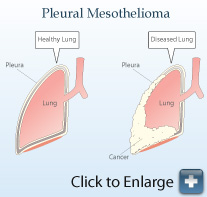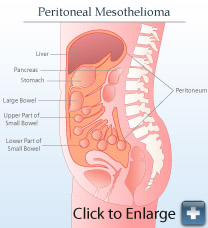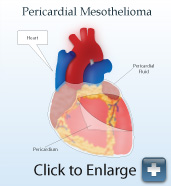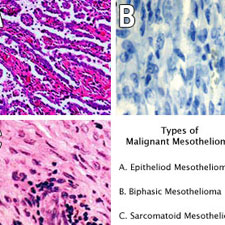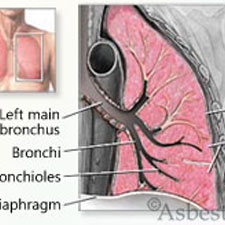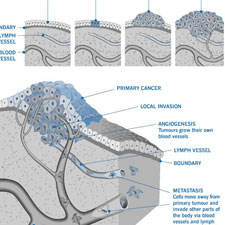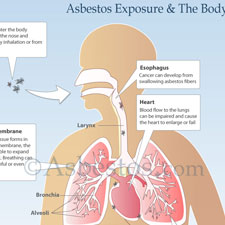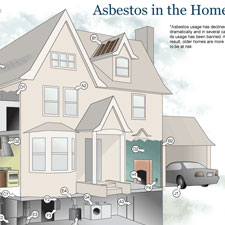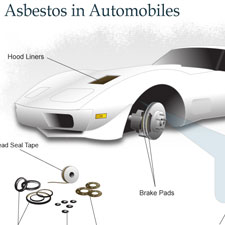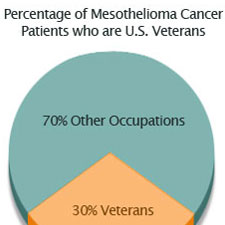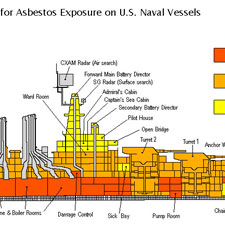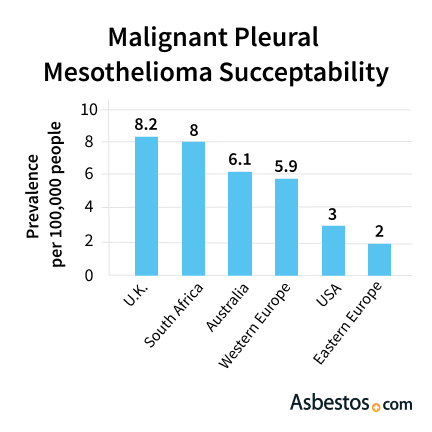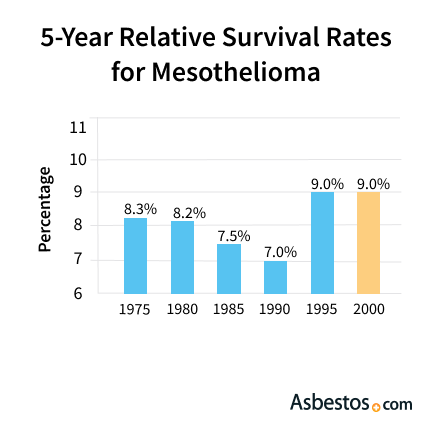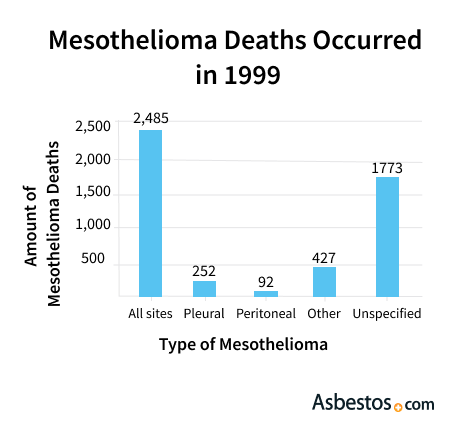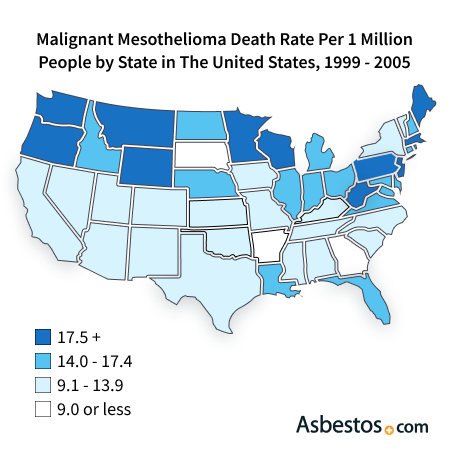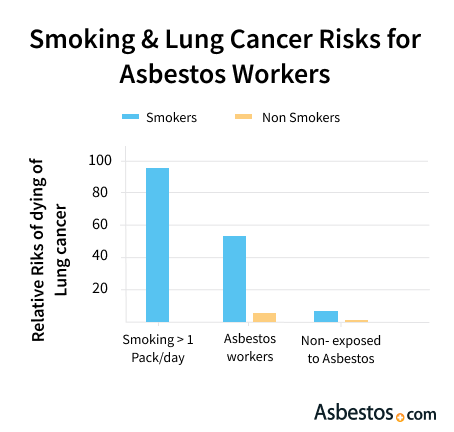Mesothelioma Images, Diagrams & Graphs
Because it is so rare and caused by exposure to asbestos, mesothelioma is a complex topic. This series of charts and graphics make understanding the cancer easier, including how and where it develops, how susceptible the disease is and common locations for asbestos exposure.

Images of the Types of Mesothelioma
Pleural Mesothelioma
This image depicts the effects of asbestos fibers. After inhaling them into the body, they move to the pleural membrane lining the lungs. The fibers become lodged in the pleura, causing inflammation and infection. Overtime, this causes mesothelial cells to become cancerous. The cancerous cells then divide without limits. This results in the thickening of pleural membranes. Patients may have constant cough, chest pains and difficulty breathing.
Peritoneal Mesothelioma
This image highlights the location of the peritoneum. This membrane lines the abdominal cavity where this asbestos cancer develops. Asbestos fibers can become stuck in the peritoneal layers of the membrane. This causes the cells to become cancerous. The cancerous cells then divide and cause the peritoneum to thicken. The growth also causes fluid buildup and tumor growth. Peritoneal patients may have abdominal pain or swelling, nausea, night sweats and fatigue. About 2,000 to 3,000 asbestos cancer diagnoses occur in the United States every year, and 10% to 20% of the patients have peritoneal mesothelioma.
Pericardial Mesothelioma
This image shows fluid that can develop in the pericardium. This membrane surrounds and protects the heart. Fluid can occur after asbestos fibers enter the body. In pericardial patients, the fibers become lodged in the pericardium, where the body cannot expel the fibers. The fibers then remain in the pericardium for decades. This causes inflammation and infection, leading to cellular changes. As cells in the pericardium become cancerous, they divide without limit. This causes the pericardial membranes to thicken, which then causes fluid build-up and the formation of tumors.
Malignant Mesothelioma Cells
This image displays three separate types of cancer cell structures. These include epithelial, biphasic and sarcomatoid. Not shown is desmoplastic. This is a variant of the sarcomatoid type. According to a 2021 study, it makes up about 34% of pleural mesothelioma cases. About 50% to 70% of malignant cases are epithelial, but sarcomatoid and biphasic are also common types.
Learn about your diagnosis, top doctors and paying for treatment.
Get Your Free GuideDoctor-reviewed, ships overnight for free

Images of How Mesothelioma Develops
Lung Diagram
This image details the anatomy of the lung. It highlights the lining of the lungs, known as the pleura. This is where pleural mesothelioma develops. This form of cancer develops when the mesothelial cells that line the pleura become cancerous and divide. This causes the pleura to thicken. Fluid builds up, and the formation of tumors can cause difficulty breathing and chest pains, among other symptoms.
How Mesothelioma Develops
Asbestos exposure causes mesothelioma. Fibers enter the body and cause tumors to form. This diagram shows the step-by-step process of its development.
Asbestos Exposure
This image demonstrates how asbestos fibers affect the body once inhaled or ingested. Fibers can become lodged in organs and body cavities, causing inflammation or infection. Over time, this leads to serious asbestos-related illnesses. In this image, fibers affect the lining of the lungs, abdomen and heart. If fibers become lodged in the mesothelial membrane, they can cause cells to become cancerous. This results in mesothelioma.
Sources of Asbestos Exposure Diagrams
Asbestos Use in the Home
Asbestos occurs in nature as a mineral. Companies used the mineral in thousands of products. Its insulating and fireproofing capabilities were effective. Asbestos products were also cheap. Construction workers used these materials to build homes. This diagram displays where products with asbestos may exist in the house.
Asbestos Use in Automobiles
The automotive industry was one of the primary sources of asbestos exposure. Those who worked in the industry suffered from mesothelioma as an occupational disease. Mechanics had asbestos exposure from working with a variety of car parts. This diagram shows the locations of car parts that had asbestos.
Mesothelioma & Veterans
The U.S. military used materials that contained asbestos in many ways. World War II veterans and those who served through the 1970s risk developing asbestos diseases. This chart shows the impact that asbestos exposure has had on military veterans.
Asbestos Use on Ships
The military used more than 300 products that contained asbestos. The Navy was the largest offender. Almost every ship built for the Navy before the 1970s contained asbestos materials. These provided insulation and fireproofing measures. This diagram displays the locations of asbestos on ships. It also shows where crew members may have had asbestos exposure.
Graphs of Mesothelioma Statistics
Malignant Pleural Mesothelioma Susceptibility
This graph details susceptibility per 100,000 people, organized by country. The United Kingdom has the highest rate, with 8.2 pleural patients per 100,000. It’s the most common form of this cancer. It comprises approximately 70% of diagnoses. Patients often do not show symptoms of the disease until it has progressed to later stages. This can make diagnosis difficult.
5-Year Survival Rates
This graph depicts the five-year relative survival rate for mesothelioma. The chart is in five-year increments from 1975 through 2000. The five-year relative survival rate for patients is approximately 10%. A cure does not currently exist. Patients may elect to undergo treatment to improve symptoms or survival. Doctors recommend surgery, chemotherapy or radiation. These depend on each patient’s disease and history.
Death Rates
The graph in this image represents malignant mesothelioma deaths in the United States in 1999. There are four different types of this type of cancer. The two most common types, pleural and peritoneal, are shown in the graph. Patients may also have pericardial or testicular mesothelioma, although these forms are very rare.
Death Rates by State
The United States has been significantly affected by asbestos exposure and associated illnesses. One such illness is mesothelioma, a rare type of cancer that most commonly affects the lining of the lungs. This diagram displays the death rate by state.
Effects of Smoking & Asbestos Exposure
Those exposed to asbestos who smoke cigarettes have a much greater chance of developing lung cancer. This chart shows the relative risk of dying from lung cancer. It compares the risk for smokers exposed to asbestos and those who only have asbestos exposure. Anyone who believes they have asbestos exposure should avoid smoking or stop altogether.

